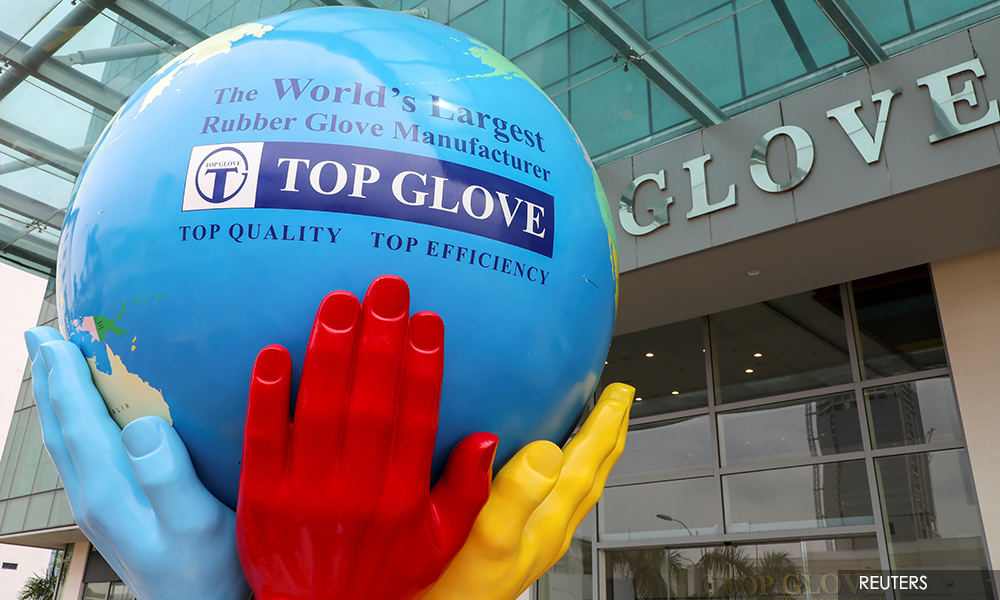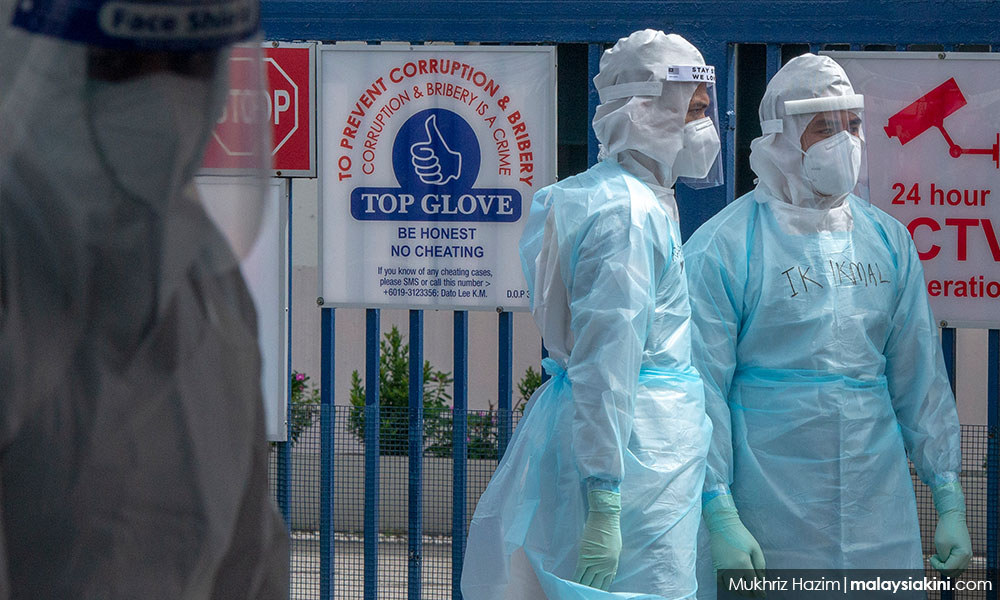Malaysia supplied 240 billion pieces of rubber gloves globally, meeting almost 70 percent of 360 billion pieces of world demand in 2020, making it a "star" industry amidst the century's worst pandemic that has infected over 65 million and claimed 1.5 million lives globally.
Homegrown companies like Top Glove Corp Bhd, Hartalega Holdings Bhd, Supermax Corp Bhd and Kossan Rubber Industries Bhd were consistently in the limelight as the demand for rubber gloves spiked not only for medical but also non-medical purposes, especially food and beverages.
The industry emerged to be extremely lucrative that companies like Luster Industries Bhd, whose primary activity is in manufacturing and selling precision plastic parts, as well as property developer Mah Sing Group, have diversified into rubber glove making.
However, with booming demand and fame brought about by Covid-19, comes unprecedented responsibilities and challenges, making it a year of mixed fortunes for the industry.
Rubber glove stocks the darling of Bursa Malaysia
The rubber gloves manufacturers literally dominated the local bourse in 2020.
"Within four months, March (when the government started to implement the movement control order) to July, we saw more than RM50 billion turnover, the combined market capitalisation of which has more than tripled from RM44.43 billion on Feb 28 to RM140.22 billion.
"Note that the addition of RM95.79 billion was in a short span," Inter-Pacific Asset Management Sdn Bhd chief executive officer Nazri Khan said.
He said both Hartalega and Top Glove surpassed IHH Healthcare Bhd in terms of market capitalisation and that within the above mentioned period, the glove stocks were trailing 12-month price-earnings ratio of between 51 times and over 100 times – among the highest are Hartalega at 128 times and Supermax at 100 times.
He said that the top four glove makers, namely Top Glove, Hartalega, Kossan Rubber and Supermax recorded a transaction value of more than RM40 billion - 13.5 percent of all transactions across the FTSE Bursa Malaysia Kuala Lumpur Composite Index (FBMKLCI).
Seeing the bullish performance, some analysts have described the sector as the "insurance policy" for the local stock market.
Nazri said that besides healthcare and rubber glove companies, the only other performing sector this year was technology," (hence), the asset managers do not have many options to go for but to manoeuvre around sectors that are performing only."
MIDF Research, which recently upgraded its rating of the glove sector to "positive" from "neutral", said the market capitalisation of Supermax and Kossan Rubber has stayed above the RM20 billion mark.
In fact, Supermax has been added to the FBM KLCI index stocks following the semi-annual review of the FTSE Bursa Malaysia Index Series on Dec 3.
Top Glove the "busiest" of them all

Top Glove, which commands a 26 percent share of the global rubber glove market, with a production capacity of 80.2 billion pieces per annum saw its shares soared by more than 400 percent.
Its share price enjoyed a meteoric rise of up to RM26.24 from RM1.55 on Jan 2, 2020. It conducted a share split on Sept 7, 2020, and the stock is now hovering around RM6.60.
It also recorded its best-ever quarterly net profit at RM1.29 billion in the fourth quarter ended Aug 31, 2020 (Q4FY20), which is almost 18 times the RM74.17 million it posted in the same quarter last year.
Net profit for its financial year ended Aug 31, 2020, stood at RM1.86 billion, which was 417 percent higher than last year. Revenue surged to RM7.23 billion from RM4.8 billion last year.
Besides Malaysia, Top Glove also has manufacturing facilities in Thailand, Vietnam and China. It exports to over 2,000 customers in 195 countries worldwide. The export value for rubber gloves has been growing by 9.4 percent at 10 years compound annual growth rate amid rising demand.
Top Glove is also listed on Singapore's stock market since 2016.
Besides Top Glove and other big boys, the small-cap rubber glove firms also showcased sterling financial results.
The ban, virus outbreak in dormitory and probes
When Malaysia imposed a lockdown to contain the spread of Covid-19 in March, the rubber glove manufacturers were allowed to operate at only half their capacities, resulting in production shortage and fear of not being able to meet global demand.
However, this was resolved when the Malaysian Rubber Glove Manufacturers Association (Margma) stepped in to help sort it out.
It was perhaps the smallest of the many challenges the industry faced in the year.
The ban on Top Glove's subsidiaries - Top Glove Sdn Bhd and TG Medical Sdn Bhd - by the United States Customs and Border Protection (US CBP) in July over "forced labour" concerns, took a big toll on the company with the share price plummeting by 10 percent to RM19.70 on July 16.
On the same day, vaccine hopes and subsequent knee-jerk reaction led to a total of RM10.5 billion worth of market capitalisation wiped out from four counters, namely Top Glove, Hartalega, Supermax and Kossan Rubber.
And while the largest glove maker was sweating it out to settle the issue on the ban, more than 4,000 of its workers were infected by Covid-19, making it the biggest contributor to Malaysia's Covid-19 cases with a cluster dubbed as "Teratai".
Top Glove was slapped with possible charges for alleged offences under the Workers' Minimum Standards of Housing and Amenities Act 1990 (Act 446).
The manufacturer had to shut down its factories in stages to conduct Covid-19 screenings, while the Enhanced Movement Control Order imposed on the workers' dormitory has been extended until Dec 14.

It was reported that Top Glove's 20 facilities were temporarily closed with eight production lines still operating in Klang, thus reducing its production by between 10 percent and 20 percent.
The company expects its revenue for the current financial year ending Aug 31, 2021, to be impacted by three percent following the temporary suspension of its manufacturing facilities in Klang.
Despite all these, research houses maintained their "like" status on Top Glove since it was the key beneficiary of rubber glove demand globally.
On the flip side, this year also saw the US CBP relented and lifted the ban on WRP Asia Pacific Sdn Bhd as to help meet its demand for the medical rubber gloves. This was after the Sepang-based company also faced a backlash from the United States, which alleged the company used forced labour in its operations.
Vaccine and 2021 Outlook
Despite these setbacks, the industry is expected to extend its bullish sentiment in line with the deployment of the Covid-19 vaccine, which is set to boost the demand for rubber gloves by up to 18 billion pieces a year, assuming that 60 percent of the world's population of 7.5 billion people would get the vaccine in two doses annually.
Malaysia's market share is expected to improve to 68 percent when the country supplies 280 billion pieces of rubber gloves next year (against the 410 billion pieces world demand) from the 67 percent market share in 2020 (360 billion pieces world demand).
It is estimated that the new players' (like Luster and Mah Sing) contribution to Malaysia's total will be only about five to seven billion gloves in 2021 and 10 to 12 billion gloves in 2022.
"Still, the biggest growth of the glove industry in 2021 and 2022 will principally be contributed by the existing 57 manufacturers, which will be able to do so due to their continuous planned expansion year-on-year, over the past 15 years," Margma president Supramaniam Shanmugam said.
The association is also optimistic that Top Glove would resolve all current matters and be back to normal production levels soon, he said.
"In the interim, the impact to the industry will be small as the shortfall can be mitigated by the newly expanded capacities of the other existing players in the industry," he added.
Margma predicts the industry's revenue at RM32.2 billion this year, higher from the RM19.8 billion recorded in 2019. For 2021, revenue could range between RM36 billion and RM38 billion, on the back of robust demand, notwithstanding the vaccine coming into play.
Bank Islam Malaysia Bhd economist Adam Mohamed Rahim is also positive of the industry performance in view that demand growth would continue in 2022 as awareness towards health and personal hygiene are likely to remain prevalent as the general society is embracing the new normal.
"Therefore, demand for personal protective equipment, including gloves, would help drive demand post-Covid-19. Expansion plans for major rubber glove makers are so far on track.
For example, Hartalega stays focused on its capacity expansion plans. As of late October 2020, Plant 6 has fully commissioned all 12 production lines and Plant 7 is expected to begin commissioning by the fourth quarter of 2020.
Overall, its plan on increasing its annual installed capacity from the current 41 billion to 44 billion pieces by 2022 remains intact.
"Therefore, we expect an increase in average selling prices in the coming quarters," he noted.
While the obstacles and challenges would continue, the industry, without a doubt, is in for another splendid year in 2021.
- Bernama




No comments:
Post a Comment
Note: Only a member of this blog may post a comment.